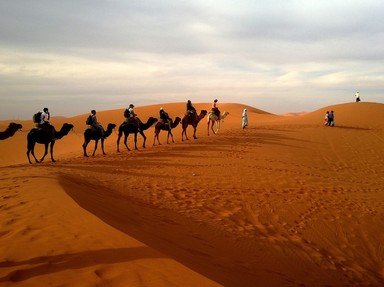Quiz Answer Key and Fun Facts
1. "Sahara" means "The Greatest Desert". Thinking carefully about the definition of a desert, is the Sahara Desert the largest in the world?
2. The African landscape has a large proportion attributed as desert. While the Sahara covers much of north and west Africa, only one of the listed countries contains a portion of the Sahara. Which one?
3. The Sahara covers an area of some 9.2 million square kilometres (3,600,000 sq. mi). This is a huge area equivalent to which of the following?
4. Stereotypically, the Sahara is depicted as an endless panorama of sand dunes when in fact the landscape is quite diverse. Which one of the following is *NOT* a feature of the Sahara?
5. In the far western reaches of the Sahara, there is something called the "Eye of the Sahara". What is this?
6. There are a few cities in the Sahara: Timbuktu, Tamanrasset, Ouargla, Béchar, Hassi Messaoud, Ghardaïa, El Oued, Agadez, Nouakchott, Ghat and Faya-Largeau. One is a capital city of which country?
7. True or false: One town in the Sahara in Algeria has had at least three snow falls including one fall of 40cm.
8. For such a barren place the Sahara has an enormous variety of fauna and flora. Which of the following animals is *NOT* found in the Sahara?
9. The Sahara has not always been a dry hostile place. What evidence suggest there was much water in the region?
10. In the scramble for Africa in the 19th Century, the Sahara was claimed in portions by a number of European powers. Which country did *NOT* claim part of the Sahara Desert?
Source: Author
1nn1
This quiz was reviewed by FunTrivia editor
agony before going online.
Any errors found in FunTrivia content are routinely corrected through our feedback system.
